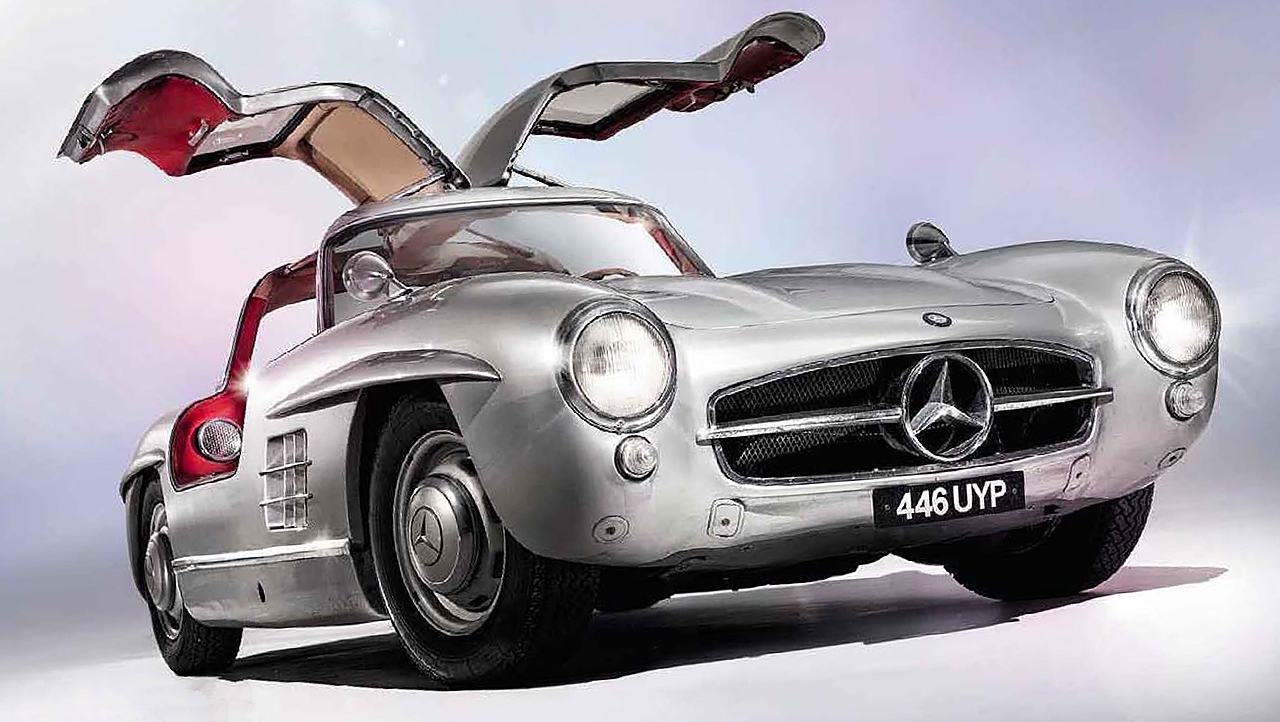
40 years with a Gullwing. The ups and downs of 40 years with a £2300 SL W198. Wing and a Prayer. Octane’s Delwyn Mallett saw a Mercedes-Benz Gullwing in Swinging London during the 1960s and vowed that one day he would own one. His dream came true in 1974 – and here he describes what it’s like to have lived with the car for more than 40 years. Photography James Lipman.
Mercedes-Benz Gullwing W198 Delwyn Mallett on living with a 300SL for 40 years – plus the Gullwing in motor sport.
The Sixties. London is in full swing and I’m at the centre of it – geographically, at least. As my friends and I stroll from our advertising agency office towards Harrods, we come to an abrupt halt. A bright orange Mercedes-Benz 300SL Gullwing, the first I’ve seen ‘in the tin’, pulls up outside the famous Knightsbridge store. The passenger door springs up and a gorgeous creature, wearing what will come to be known as hot pants, unwinds herself from the interior. Traffic stops. Jaws drop. I vow to get one (a Gullwing, that is). Little do I know, then, that I will end up owning this very car.
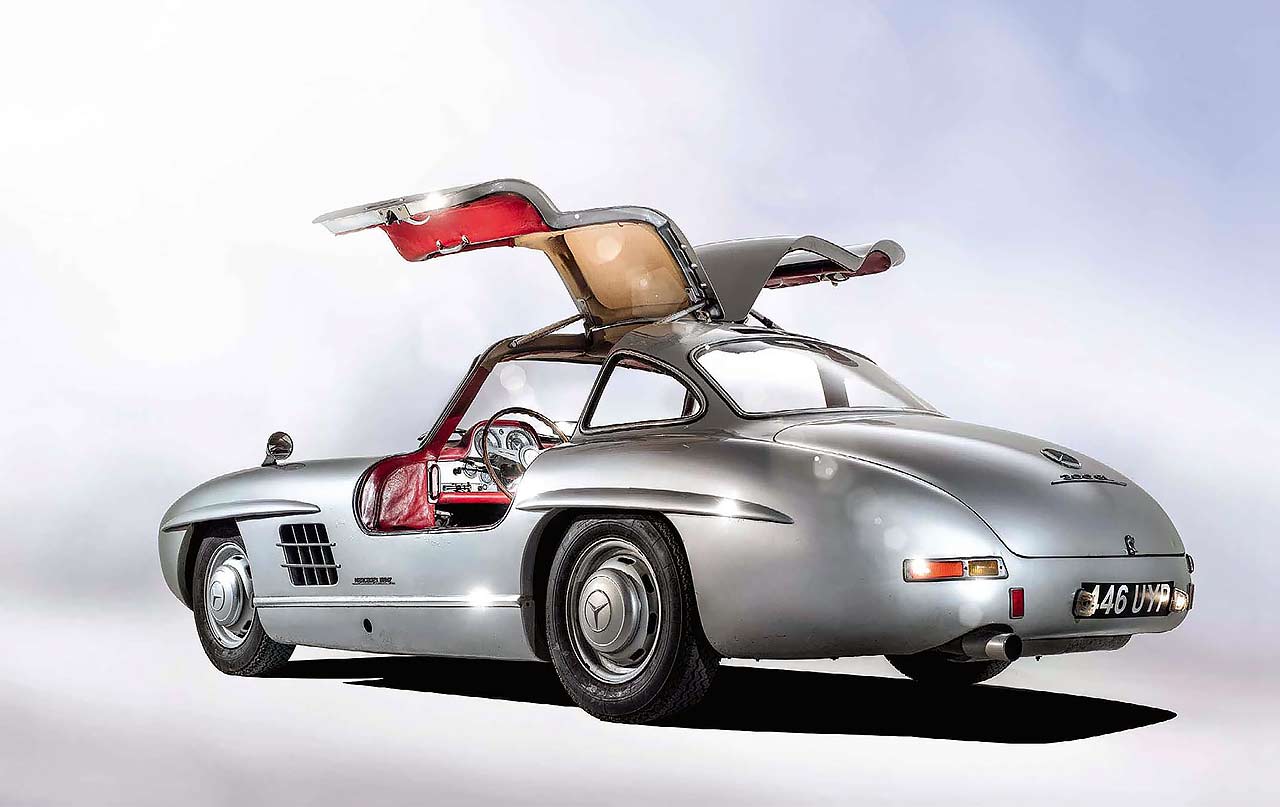
Mercedes-Benz 300SL Gullwing W198
My first brush with a Gullwing came at art school, where I discovered the French New Wave movie Ascenseur pour l’échafaud (Elevator to the Gallows). Featuring the seductive Jeanne Moreau, a soundtrack by Miles Davis and a subplot involving a teenage blouson noir joyriding around Paris in a stolen Gullwing, the film was altogether an irresistible confection for an impressionable hipster like myself. It wasn’t, however, just the pose factor that attracted me to the Gullwing: although nobody in my family showed the slightest interest in cars, I had from my Dinky Toy days been motor-mad.
Mercedes pilot Stirling Moss was a hero of mine, but it was the Shell History Of Motor Racing films directed by Bill Mason (Nick’s dad) that really fired my imagination and turned me on to German cars in particular. And it was the episode titled Clash of the Titans, an account of the epic battles between the statesponsored teams of Mercedes and Auto Union, that sowed the seeds of a fascination with all things Porsche and Mercedes.
In 1974, after several years working as an advertising art director, my personal financial circumstances were on the up but those of the nation were definitely on a downward curve.
The pound was floundering against world currencies (sounds familiar?), particularly the German Mark, and inflation stood at a 30-year high. We had recently joined the European Community and a referendum on whether we should stay in was just months away.
Mercedes ran a full-page press ad in national newspapers featuring a Gullwing that had sold at auction for around £5000, pointing out that as an investment it had outperformed the stock market. As if I needed an excuse.
My daily driver, a BMW 2002tii, moved on and for roughly the price of a replacement, around £2300, I became the proud owner of an ‘inflation-proof’ Gullwing. Actually, ‘proud’ doesn’t quite do it: I had attained automotive nirvana. At half the price of a really good one, my car – which was painted silver when I acquired it – was clearly not the best in the country, but it was mine!
My friends, of course, thought I was quite mad. In the 1960s and ’70s to the general public old cars were just that – old, and the lot of those who couldn’t afford new. Some were appreciated in a ‘haven’t seen one of those for years’ way, but they conferred no status upon the owner outside of a small circle of enthusiasts. And they were categorically not an indicator of wealth.
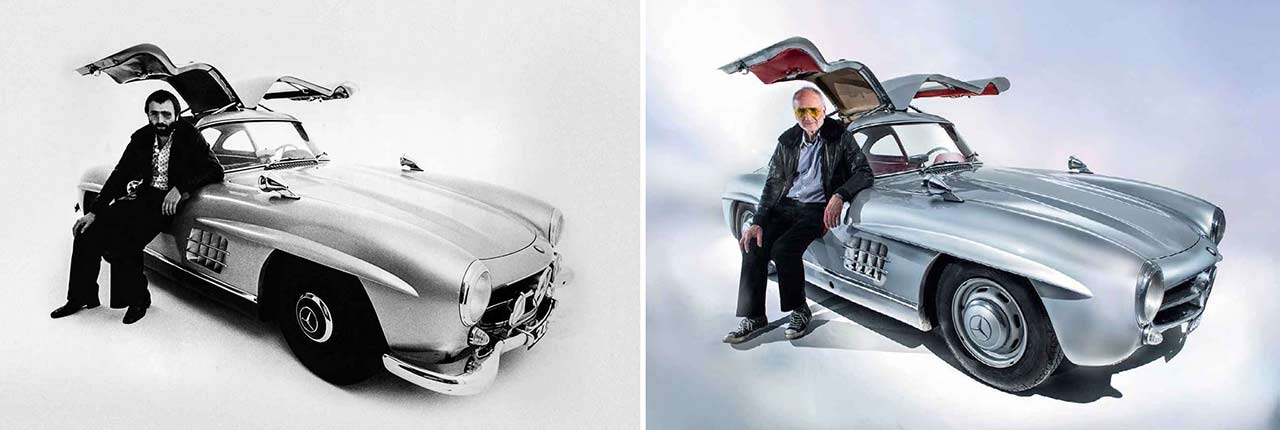
Clockwise from top left. Car and owner in 1973, and in 2016 – the glasses and jacket may no longer be the height of fashion but the Gullwing looks as good as ever; the car had been painted silver by the time Delwyn bought it, but sported a rather more outlandish get-up in the hands of a previous owner.
Much has changed in the 40-plus years since then, but the Gullwing’s place in my affections – and my garage – has not. At its launch in 1954 the 300SL (for our purposes the term is interchangeable with ‘Gullwing’) introduced the world to the concept of the supercar, and super it still is. Very super.
Even today it is an arresting sight, and the angry bark of the fuel-injected straight-six as it hits its stride above 4000rpm remains utterly exhilarating. That its performance can still thrill should be no surprise: the roadgoing 300SL was derived from the W194 competition car of 1952, and even as it was ‘civilised’ for street use it grew more powerful than its parent car.
Each 300SL engine was run-in on a dynamometer for 24 hours, six under full load, then disassembled, checked, rebuilt and returned to the dynamometer for another eight-hour session before being declared drehfest – meaning that if supplied with clean fuel, oil and air, the engine would deliver its maximum 240bhp at 6100rpm as near to indefinitely as damn-it.
On the road the Merc certainly feels as if it could run forever. Through the 1970s, apart from my daily commute, the Merc was used properly on long Continental blasts where, unleashed, it felt much more at home with its high-ratio rear axle option.
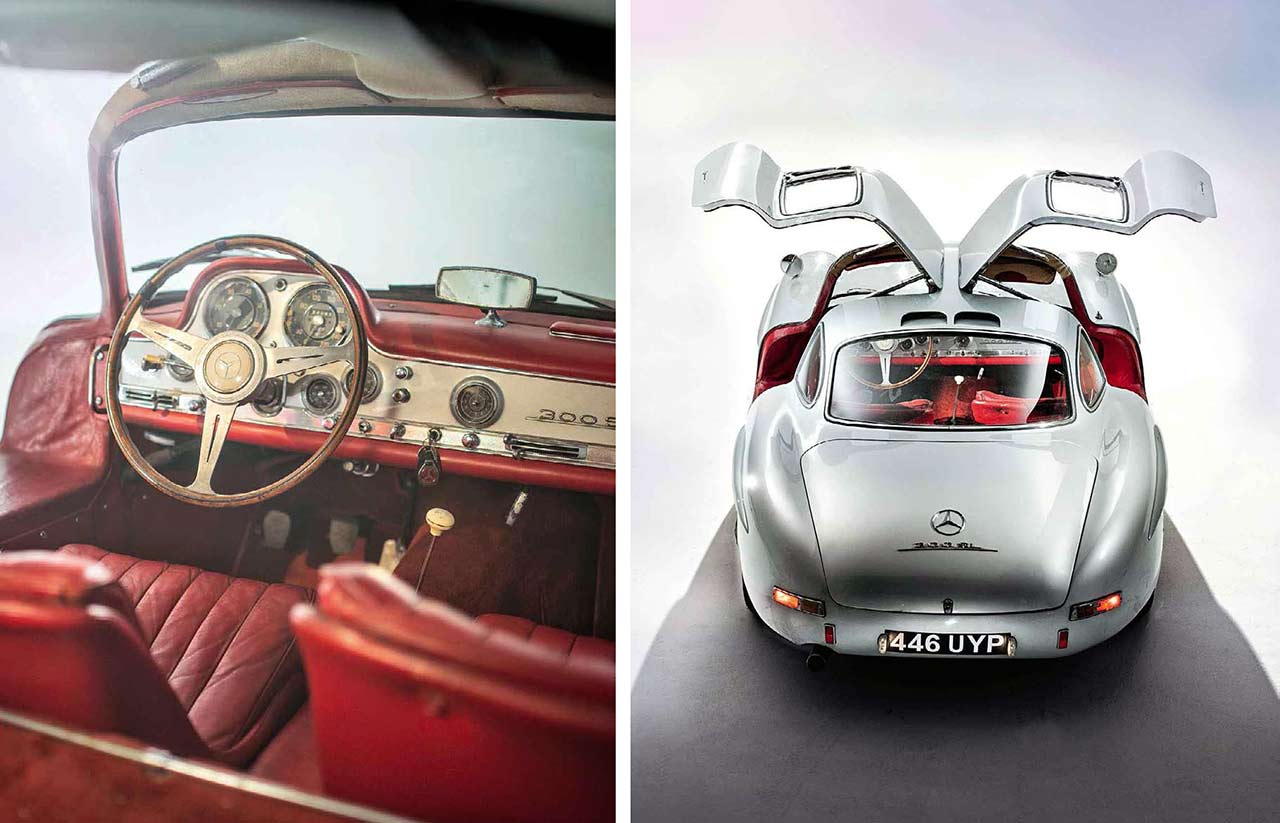
Mercedes-Benz 300SL Gullwing W198 interior LHD
On an early trip across pre-euro France I stopped for juice at a rural petrol station and in my schoolboy French asked for cent Francs’ worth. The elderly lady serving me shook her head at such an impossibility and, like De Gaulle turning down Britain’s application to join the Common Market, emitted a series of emphatic nons. With a sigh, not sure that my wallet could take the strain, I uttered ‘plein, s’il vous plait’. Satisfied with her victory, she began the filling process, only to register astonishment as her ancient pump ran out of figures long before the Merc’s mammoth 127-litre tank had been brimmed. From the cascade of French that followed I gathered she was most apologetic for doubting my original request.
It was an expensive misunderstanding, but one soon forgotten; in its natural environment and on the right day, the Gullwing assaults the senses so completely and so wonderfully that from behind the wheel it is impossible to focus on anything else.
The ownership experience is not all admiring looks and Grand Tours, though. For those of you who despair of current Gullwing prices, here’s the good news…
It is hard to get into, harder to get out of, and harder still to negotiate as one’s flexibility decreases with age. The much-commented-on fold-down steering wheel facility is almost useless in practice, as it only creates extra space when the front wheels are in a precise straightahead position.
Cabin heat is high at best and almost unbearable on warm days. The side windows are removable but have to be stowed somewhere other than the boot, which is totally given over to the spare wheel and that fuel tank.
Even with the windows out the good aerodynamics preclude any cooling drafts through the interior.
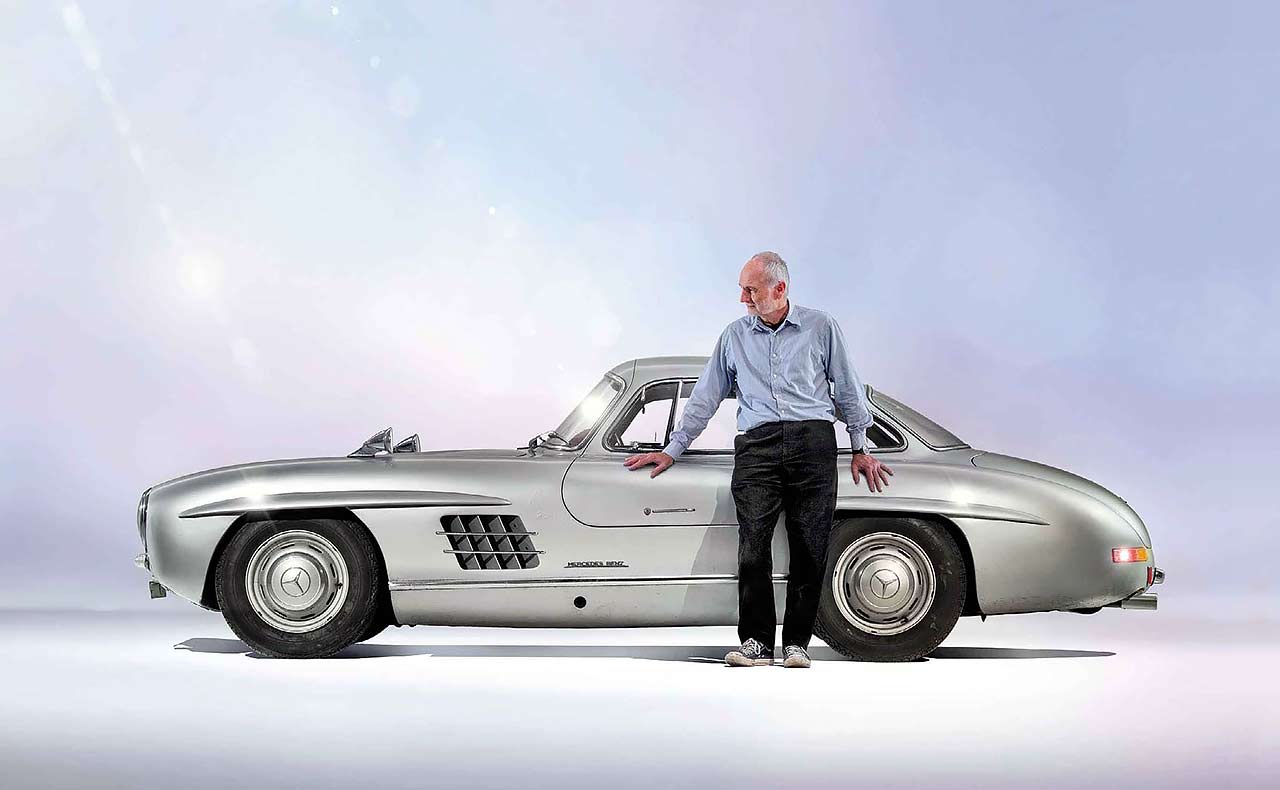
Mercedes-Benz 300SL Gullwing W198
From new, heat transfer to the fuel injection pump caused fuel vaporisation and difficult starting when hot, a problem that in my car’s case has got worse over the years.
The rear-view mirror is mounted on the dash and the stalk is too short to provide a decent view out of the rear screen. With luggage stacked on the rear shelf (the only place to put it, remember), there is no rearward vision at all. The steering is also very heavy at low speed.
Rob Walker was the first owner of a Gullwing in Britain, his car delivered on the last day of 1954, and several observations from his report for Motor Sport magazine bear repeating here.
‘When I first had the car I found cornering a little difficult. In fact, I had one or two distinctly uneasy moments when the car suddenly felt as if it was on ice… I mentioned this to Stirling Moss, who told me that they handled very well indeed but the swing axle takes a bit of getting used to, and I must say I don’t find any trouble now and never think about it.’
Not possessing the skills of Rob Walker (and certainly not those of Sir Stirling), even after four decades in the saddle I have never quite got over the feeling of anxiety when approaching bends at speed; I certainly do ‘think about it’.
In a later road test for the same magazine, the editor Bill Boddy commented: ‘The brakes, while stopping this 24cwt car very reasonably from three-figure speeds… are rather slow, then fierce, in action, as the servo takes effect, and consequently to apply them hard on a slippery surface is a practice to be avoided whenever possible. Too hard an application of the brakes produces a smell of hot lining within the car and tends to cause snaking.’
This I can vouch for, having experienced a sphincter-loosening incident one wet and windy night on a badly lit stretch of autobahn. As I arrived too fast at an unexpected diversion from one carriageway to another, the car adopted a wriggle that a rattlesnake would have envied. I finally came to a stop, pulse racing, in a coned-off zone – mercifully without damage. In all sorts of ways, then, the Gullwing is not perfect, but the car’s spectacular virtues have always outweighed its practical flaws.
Familiarity has not bred contempt; I might occasionally have cursed the aforementioned fuel injection pump or the high, wide sills or the rear visibility, but far more frequently I am scarcely able to believe my own good fortune on opening the garage door of a morning.
And as I sit in the studio while my car is being photographed for this story, I find myself gazing at it more intently than at any time in the past 40 years. What a pleasure it is.
I banished the bumpers to the garage loft some years ago when I stopped using the car in town. The car simply looks better without the heavy chrome exclusion zones at either end, revealing the voluptuous curve of its derrière and the way the line of the nose sweeps gracefully under the car at an angle which, if continued through the wheel opening, aligns beautifully with the sill – itself subtly contoured from front to rear.
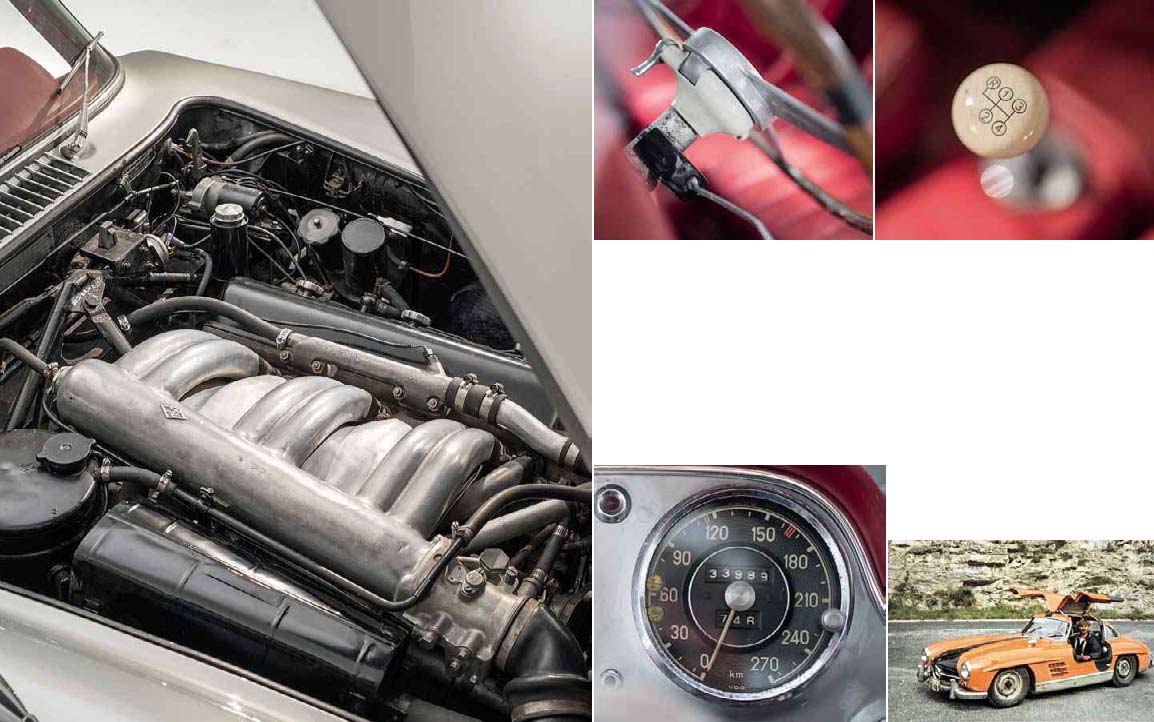
Clockwise from above. It’s not only the Gullwing’s looks that set the pulse racing: the 2996cc straight-six offers proper racing car performance; the semi-useless fold-down steering wheel mechanism at least makes a good talking point; Delwyn’s most significant modification to the car was the addition of these ‘30’ and ‘40’ stickers to the km/honly speedo; the gearstick knob wears its age well.
At art school I was frequently challenged for what seemed to some students an unhealthy obsession with cars. I would respond that they were not mere transport but ‘kinetic art’, pieces of mobile sculpture; little did I imagine that in only a few decades old bangers would actually attain the value of old masters.
The many details that mark out this particular mobile sculpture as my own are picked out by the studio lights: the ancient, handwritten ‘30’ and ‘40’ stickers affixed to the speedometer that displays only kilometres; the patinated leather driver’s seat in which I have spent so many hours; the gearstick knob cracked with age. After 40 years I know this car as well as I know my wife. Or so I thought…
Recently I was passed a letter by 300SL guru Martin Cushway. The letter, a request for information by the chap from whom I bought the Gullwing, had been sent to Martin’s father, Ron. It mentions that the car, ‘orange with a wide black stripe down the centre’, was reputed to have once belonged to Steve McQueen.
The letter was written in 1969, long before ‘ex-McQueen’ motors had come to be regarded as holy relics, so nothing to be gained. Neile Adams, the star’s wife of many years, mentions in her biography that McQueen owned (and crashed) a Gullwing in Germany when shooting The Great Escape, but as far as I know no photographs have surfaced of him in proximity to a Gullwing.
Considering how relentlessly McQueen was photographed at the height of his fame, this casts doubt on the claim – but who knows? The car that first floored me all those years ago at art school continues to find ways to surprise.
If anyone can shed light on the car’s early history, please get in touch via Chris. Delwyn’s car was first registered SHM 14F in the UK, and the chassis and engine numbers are 5500850 and 198980. Photographs of the car with Steve McQueen gratefully received!
‘NOT POSSESSING THE SKILLS OF SIR STIRLING, I HAVE NEVER QUITE GOT OVER THE FEELING OF ANXIETY WHEN APPROACHING BENDS AT SPEED’
TECHNICAL DATA 1955 Mercedes-Benz 300SL ‘Gullwing’ W198
Engine 2996cc straight-six, OHC, Bosch mechanical fuel injection
Power 240bhp @ 6100rpm
Torque 217lb ft @ 4800rpm
Transmission Four-speed manual, rear-wheel drive
Steering Recirculating ball
Suspension Front: double wishbones, coil springs, anti-roll bar.
Rear: swing axle, radius arms, coil springs
Brakes Drums, servo assisted
Weight 1252kg
Performance Top speed 135mph. 0-60mph 8.8sec





